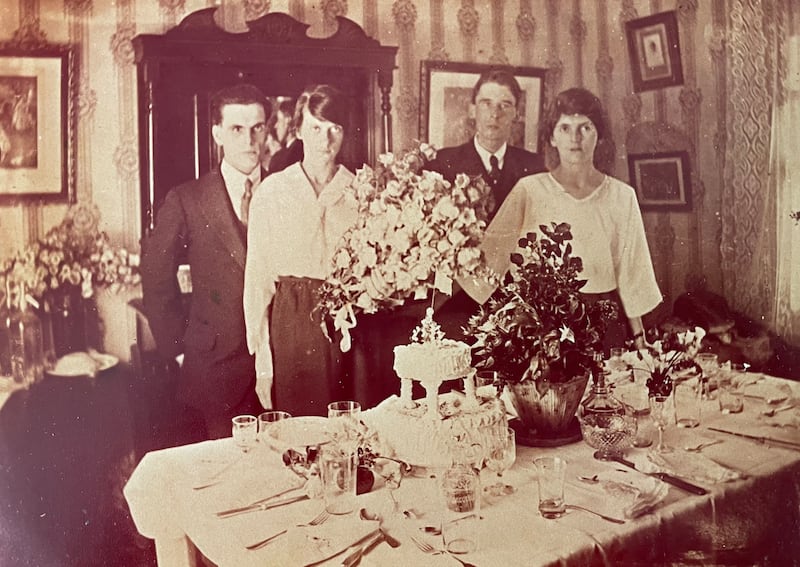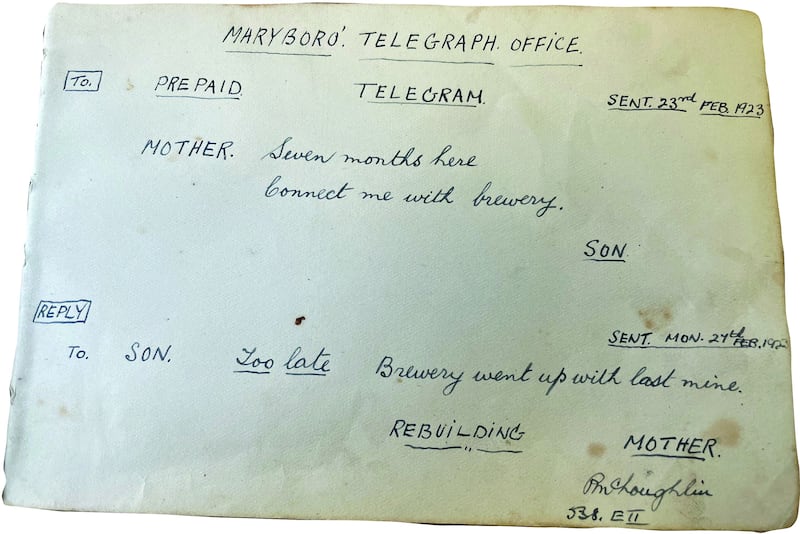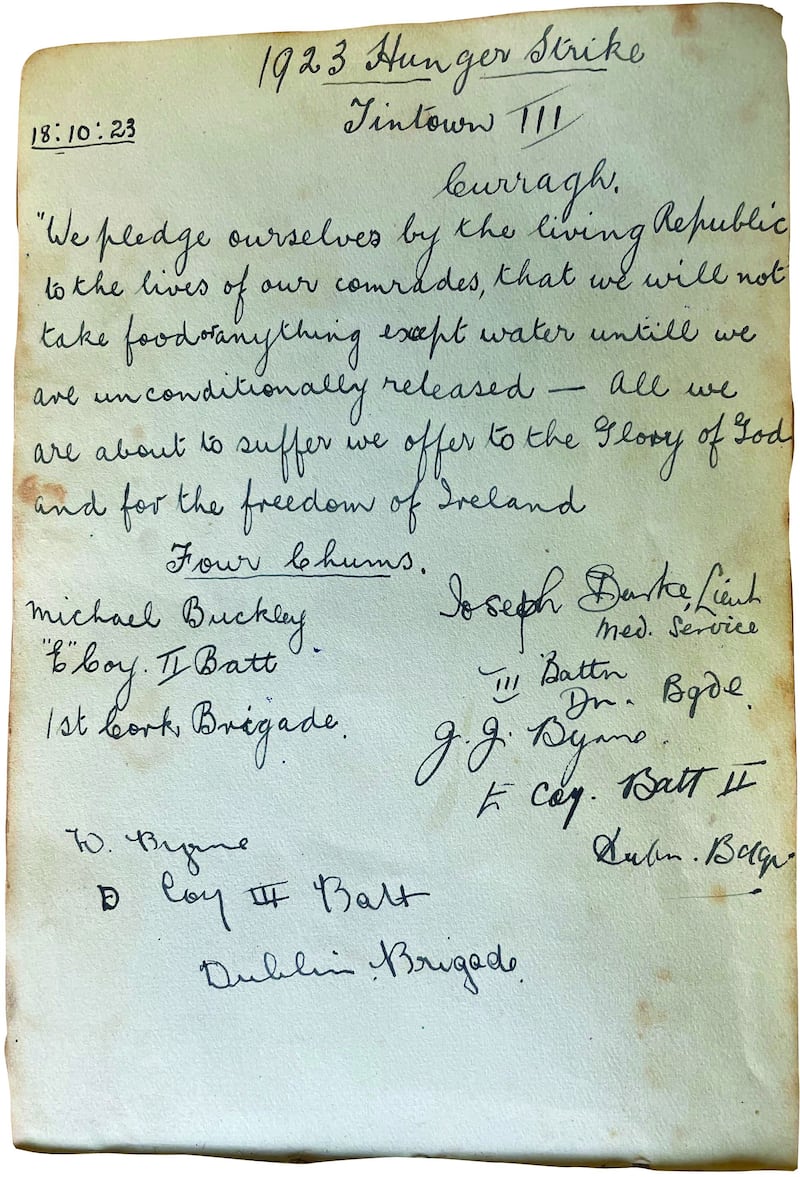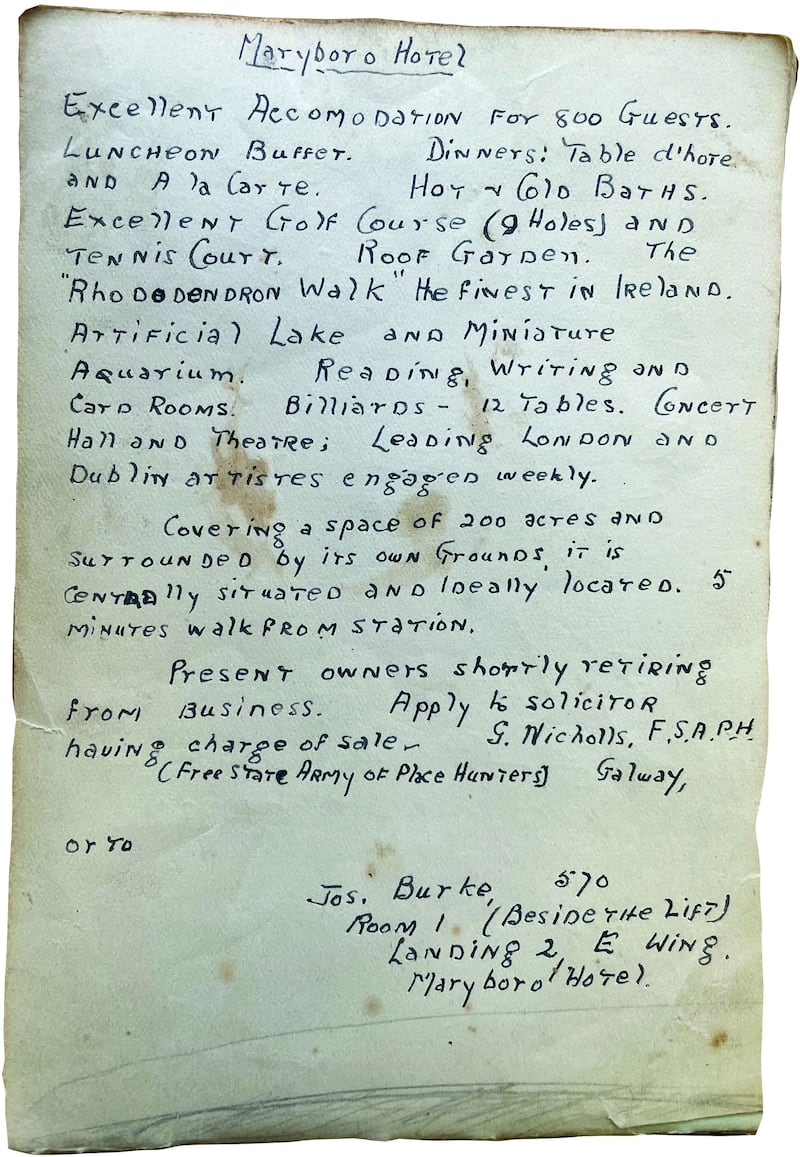I hadn’t planned to write a historical novel.
My writing generally explores contemporary themes and relationships, and although I research backgrounds and locations so that they are accurate, I’m always confident about the social history of the time I’m writing in, because I’m living it myself. In fact, observing people while sitting in a cafe or travelling into Dublin by bus or Dart is my preferred method of social research.
I couldn’t do that during lockdown, however, so I found myself retreating into the past, constantly looking for historical parallels to deal with what we were experiencing in the present. As I took my daily walks along the seafront, my thoughts frequently turned towards my late grandmother and the world events she’d lived through. Even though she died more than 40 years ago, I could almost hear her voice retelling some of the stories she’d shared with me when I was very young.
Born in 1901, Winifred O’Leary – or Mudsie, as we called her – experienced two World Wars as well as the Easter Rising, the Spanish flu epidemic and, of course, both the War of Independence and the Civil War. She didn’t often speak about her experiences as a young woman, but whenever she did she was witty and vivacious, invariably using the perfect word or phrase to wickedly describe a person, a place or an event. As I walked the seafront, I remembered the days she brought me to the Gresham Hotel for an afternoon treat – to teach me, she’d say, how to behave in company.
From Baby Reindeer and The Traitors to Bodkin and The 2 Johnnies Late Night Lock In: The best and worst television of 2024
100 Years of Solitude review: A woozy, feverish watch to be savoured in bite-sized portions
How your mini travel shampoo is costing your pocket and the planet - here’s an alternative
While we had tea and cake, she’d tell me about “bowsies and blackguards”, evading checkpoints and making ends meet in the most difficult of circumstances. I learned about the house at St Anthony’s Place – gone now but, at the time, next to the chapel of Temple Street children’s hospital – where her formidable mother-in-law sheltered prominent as well as unknown Irish Volunteers, as she referred to all those fighting or politically involved in the War of Independence who might need shelter at any time; their home was raided more than once in attempts to find them.

I particularly remember her talking about the crypt beneath the convent where the bodies of deceased nuns were interred and which could be accessed from her mother-in-law’s house. She told me that it was the eeriest place she’d ever seen and that, when she’d hidden there during a raid on the house, she’d been more terrified of the dead bodies rising up than of being caught by the British soldiers. Her telling of the raid itself was sketchy – she seemed to have dismissed it as just another incident – but her description of hiding in the crypt made it a very exciting scene for me to write, though I’m sure it was excitement the young Winnie could have done without.
Although I’m not the sort of writer who jots everything down in a notebook, I began to write down short scenes of those remembered stories, and as restrictions continued I accumulated pages of written recollections along with a general timeline of when the events described in them took place. I also had some family papers and, most importantly of all, my grandfather Joseph Burke’s autograph book, which he kept when he was interned during the Civil War.

Grandfather’s autograph book has always been a part of my life. When I stayed at my grandmother’s house as a child, she allowed me to take it from the bookcase to read through the pages. Some of the entries were in old Irish script that I struggled to understand; some were reflections of the situation the prisoners found themselves in at the Maryboro Hotel, as they referred to what is now Portlaoise Prison; some were filled with black humour; and others were watercolour drawings, usually with elements of Irish symbolism.
As a child, I found the autograph book fascinating, although I was unable to place any of it in context. As an adult, with a greater understanding of the history behind it, it was a very real connection with the past. A number of years ago, in order to ensure it was preserved, my mother gifted it to the National Library of Ireland. Although I had photographs of the entries, I visited the library to see it for myself once more. Turning the pages brought both of my grandparents to life again, and that was when I knew my notes would become a story.

There are many books covering the details of Irish history over the turbulent years of the War of Independence and the Civil War, explaining the background and motivations of the main players. I was more concerned with the emotional journey of my grandmother and her family during that chaotic and dangerous time. War is so overwhelming that it’s easy to overlook the day-to-day worries of those who live through it. What interested me most were the untold stories of ordinary people who found themselves living through extraordinary circumstances, particularly the stories of women who, while fighting for their beliefs, nevertheless had to hold their families together, feed their children and make everyday life as normal as possible when everything around them was not.
We forget that women like Winnie and her sisters continued to buy fabric for clothes, take the tram to the seaside, drink tea together and talk of dreams and aspirations that didn’t only include getting married and having children
The Woman on the Bridge is based on my interpretation of real events and collective family memories. The novel takes Winnie from a place where all she ever wanted was a quiet life to someone who was prepared to risk her own life for something and someone she believed in.
If there was one thing that came home very clearly to me as I both researched and wrote the book, it was the overwhelming tragedy of the Civil War. My grandmother herself was bitter about how it had fractured families and friendships, including her own: the Burkes and the O’Learys were only two of many families where different members took opposing sides for their own deeply held beliefs and reasons, and the rift it caused stayed with her forever. She also deeply regretted the damage to her husband’s friendships and could never quite believe that people who once fought side by side ended up fighting each other.
She reserved a particular ire for the role of the Catholic Church, both in its position on the war and in its subsequent insertion of itself into the running of the new Irish State. As far as she was concerned, religion had no place in the making of laws, and she regarded all pronouncements from religious leaders as unwelcome.
Writing The Woman on the Bridge was an immersive experience. I had to remind myself from time to time that the young woman I was writing about had chased me around the garden, comforted me when I got into scrapes and cared for me when I was ill. She was a woman whose obsession with hygiene in the home stemmed from the constant fear of illness, particularly tuberculosis, which infected so many people in the often cramped housing conditions of Dublin city, including some of those closest to her. From the vantage point of 2023, it’s almost surreal to know that I lived, loved and laughed with a woman born 122 years ago, and it’s hard to imagine that when she was considerably younger than I am now she watched her husband go out with a rifle and knew that he might never come home.

Before I wrote The Woman on the Bridge I was, of course, aware of Ireland’s history. And no Irish person needs telling that the seeds of the past continue to resonate in our present. It seems to me, however, that we often forget that, even through difficult times, people still met each other, laughed with each other and shared confidences with each other. We forget that women like Winnie and her sisters continued to buy fabric for clothes, take the tram to the seaside, drink tea together and talk of dreams and aspirations that didn’t only include getting married and having children. We also forget that those women who fought for an independent Ireland also wanted an Ireland of equal opportunity.
My grandmother always encouraged her daughters, and indeed her granddaughters, to form their own opinions, take nothing on trust and ignore the begrudgers. When, as a small girl, I asked her about Countess Markievicz, wanting to know if she wore ball gowns and tiaras every day, my grandmother told me that it was more important to be brave, strong and educated than to wear fancy dresses.
Along with my grandfather’s diary, the bookcase in her home contained a selection of classic literature as well as children’s books, and she allowed us to pick and choose whatever we wanted to read. I first encountered Anne of Green Gables, Heidi and What Katy Did Next on those shelves and followed on with Dickens, Austen and Wodehouse.
Even though there were difficult and dangerous times during the course of my grandmother’s story, I’ve endeavoured to show the light and happiness that were also in her life and the lives of those around her. In my travels as an author I’ve found that, no matter where I am in the world, people generally want the same things. To be safe, to be happy and to be loved. Even if the past is a different country, the dreams and desires of those who went before us are very recognisable.
Given the pride of place that the bookcase had in my grandmother’s small parlour, and the encouragement she gave me to read all it contained, I like to think that she would find some amusement – and perhaps pride – at being in a book herself. It has been a privilege to interpret her stories and shape them into the novel that became The Woman on the Bridge. More than anything, I hope I’ve brought my grandmother’s personality to life and achieved what I try to achieve in all my novels: to show the strength and resilience of women no matter the time and no matter their circumstances.
The Woman on the Bridge, by Sheila O’Flanagan, is published by Headline Review










